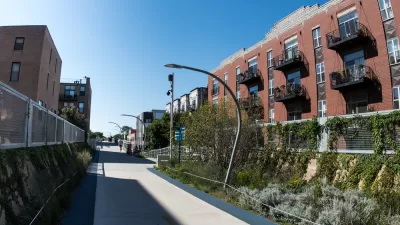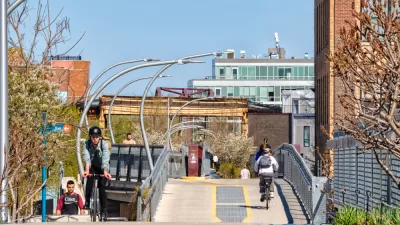That beautiful new bike lane, known as the 606, in Chicago has brought along with it local concerns about gentrification. The city and a local non-profit have teamed up to create a loan program to help current residents stay ahead of the curve.
"If you build a beautiful trail that winds through the city's hippest neighborhoods, they will come," writes Paul Biasco. "But a new program aimed at fighting gentrification around the 606 wants to make sure 'they' won't force longtime residents out of their homes."
Neighborhood Housing Services "is helping longtime residents living within a strict boundary around the elevated trail apply for $25,000 in "forgivable" loans to fix up their homes," according to Biasco. "The $1 million program is designed for modest-income homeowners and aims to preserve affordability along the trail."
The program received its funding from the city of Chicago. According to Biasco, the "Chicago Department of Planning and Development implemented the $1 million program, which is using funds from the city's Neighborhood Loan Program." The article includes more details about the real estate market context of the neighborhoods around the 606, which have already seen substantial new investment proposals from developers looking to capitalize on the new amenity, and the resulting fears of gentrification.
FULL STORY: As Area Near 606 Gentrifies, Loans Give Longtime Humboldt Residents Hope

Trump Administration Could Effectively End Housing Voucher Program
Federal officials are eyeing major cuts to the Section 8 program that helps millions of low-income households pay rent.

Planetizen Federal Action Tracker
A weekly monitor of how Trump’s orders and actions are impacting planners and planning in America.

The 120 Year Old Tiny Home Villages That Sheltered San Francisco’s Earthquake Refugees
More than a century ago, San Francisco mobilized to house thousands of residents displaced by the 1906 earthquake. Could their strategy offer a model for the present?

Alabama School Forestry Initiative Brings Trees to Schoolyards
Trees can improve physical and mental health for students and commnity members.

NYC Outdoor Dining Could Get a Re-Do
The city council is considering making the al fresco dining program year-round to address cost concerns from small businesses.

HSR Reaches Key Settlement in Northern California City
The state’s high-speed rail authority reached an agreement with Millbrae, a key city on the train’s proposed route to San Francisco.
Urban Design for Planners 1: Software Tools
This six-course series explores essential urban design concepts using open source software and equips planners with the tools they need to participate fully in the urban design process.
Planning for Universal Design
Learn the tools for implementing Universal Design in planning regulations.
Ada County Highway District
Clanton & Associates, Inc.
Jessamine County Fiscal Court
Institute for Housing and Urban Development Studies (IHS)
City of Grandview
Harvard GSD Executive Education
Toledo-Lucas County Plan Commissions
Salt Lake City
NYU Wagner Graduate School of Public Service




























